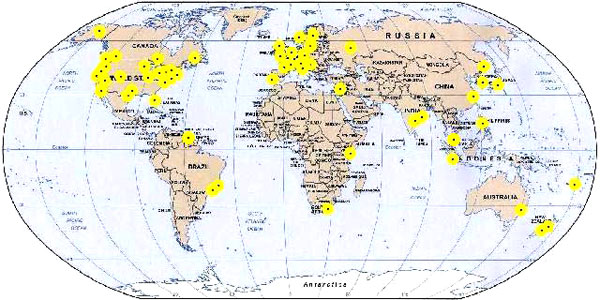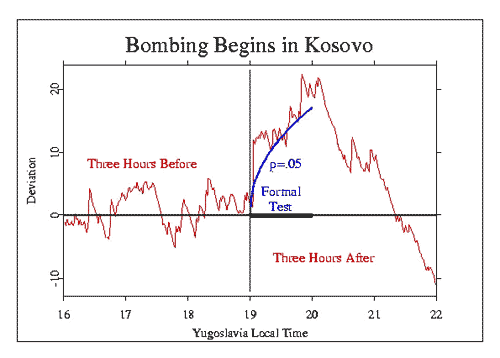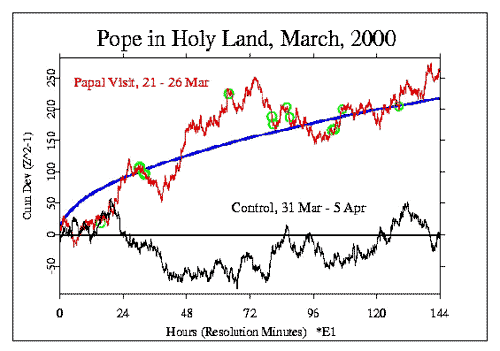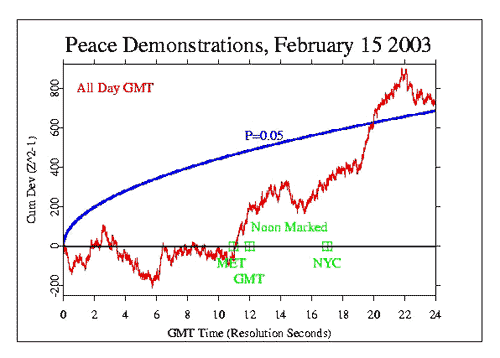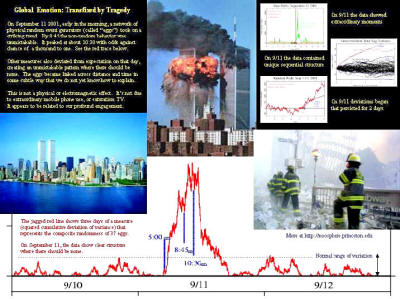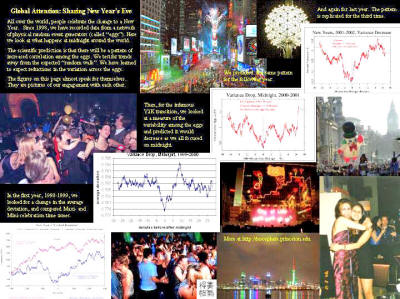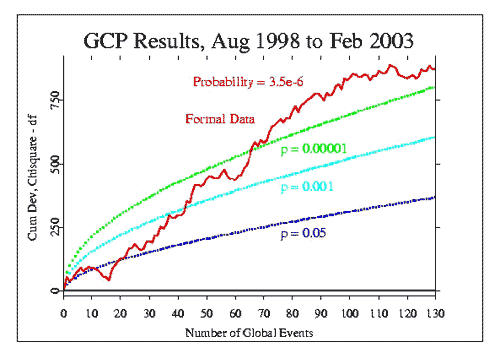|
Adapted from an article in the International Journal of Parapsychology
(Part Four of a series prepared for
The Golden Thread)
from
GlobalConsciousnessProject Website
Overview
We maintain a network of detectors located around the world in over 50 host sites ranging from Alaska to New Zealand. These devices generate random data continuously and send it for archiving to a dedicated server in Princeton, New Jersey. The data are analyzed to determine whether the sequences of unpredictable random values contain periods of structure that may be correlated with major events in the world.
According to standard physical theory, there should be no structure at all in random data. Yet, we find that many of the global events we look at are associated with striking patterns in the data. Special times like the celebrations of New Years, and tragic events like the attacks on September 11, 2001, show changes that are correlated with shared periods of deep engagement or widespread emotional reactions.
Our analyses establish that the non-random behavior cannot be attributed to mundane sources such as electrical grid stresses, mobile phone activity, or ordinary electromagnetic fields. The evidence suggests instead that the anomalous structure we see is somehow related to the unusually coherent focus of human attention generated by extraordinary events.
How do we leap to a world-spanning network testing for signs of a "global consciousness"?
Why should there be any effect of a world-wide New Year’s celebration, or the beginning of a war, or a billion people watching a funeral ceremony, on REG devices placed in far corners of the world? Although it’s only a metaphor, it may be helpful to envision a "consciousness field".
Picture a faint radiance of information extending out indefinitely from each mind, with a wavelike interpenetration creating tenuous interference patterns that differ depending on our intentions and our degree of engagement. Remember that this is a metaphor, and there is no actual physical energy that we can directly measure.
Yet, there appears to be something like a field carrying information that may be responsible for the anomalous effects in studies with REGs. Our network is designed to capture subtle effects of such a field, which we think may be a manifestation of interacting fields of thought and emotion all over the world. We are able to detect something of it whenever large numbers of people become attuned to a common interest and feeling.
Friends and colleagues around the world form a network of people with interest in the Global Consciousness Project who are willing to set up a computer to host an egg – one of our REG based detectors.
A map of the world shows the network of over 50 host sites at the beginning of 2003.
GCP eggs are located around the world, from Alaska to Fiji, on all continents and in most time zones.
Even tiny changes from what’s expected, if they are consistent, can become “statistically significant” indicators of a real effect. We interpret departures from the expected behavior in our data as a measure of something related to consciousness, following principles developed over decades of laboratory research showing that human intentions and special states of consciousness can affect the randomness of such devices.
To show how the analysis we use can reveal structure, we will look at some special cases that show with unusual clarity how graphs of the data represent the correlations we are interested in, and how these dry statistics can take on meaning.
First, a six hour period centered on the beginning of NATO bombing in Kosovo, which was judged by the Western nations and the US in particular to be the only choice available to stop the ethnic war in Yugoslavia. It was a shock to the world, even though it was not unexpected.
The GCP data appear to be markedly different before and after the beginning of the bombing. For the three-hour period leading up to the first explosion, the trace is a classic random walk, with no noticeable trend. Then, beginning abruptly at that time, the trace changes; the next three hours no longer look random. This is, of course, an interpretation of a picture of statistical quantities, and as a single instance, does not answer the question. But it is not alone. It turns out that about two thirds of our formal tests have a positive trend supporting the hypothesis, and almost 20% are statistically significant at the level where we expect 5% by chance.
Such results begin to add up to a persuasive case, even though the effects we seek to capture are subtle.
Three hours preceding and three hours following the beginning of bombing in Yugoslavia. Adapted from a figure by George deBeaumont.
An event that attracted a great deal of media attention and was followed with positive regard by people everywhere was the week-long pilgrimage of Pope John to the Middle East to sites that are regarded as the sacred locus of origin for three of the world’s major religions.
The data have a persistent trend over the six-day period that certainly does not look random. The sustained departure was so striking that I felt compelled to extract and process a special “control” dataset to be sure there was no mistake.
The control data are a splendid example of a random walk, wandering up and down, but showing no trend at all.
The Pope’s pilgrimage to the Middle East was the focus of news because it was a sign of hope for resolution of the unending strife. The lower trace is “control” data taken 10 days later.
On the 15th of February, enormous numbers of people in the great cities of the world came together in demonstrations aimed to show worldwide support for peaceful resolutions of the conflicts in Iraq and elsewhere in the Middle East.
The EGG network seemed to respond. The data are clearly random for the first few hours of the GMT day, but by 11:00, when people were assembling for major demonstrations in Berlin, Rome, and London, the composite measure departed from expectation with a steep trend that continued for the rest of the day.
Taking a careful scientific stance, we must recognize that the deviation could be just a chance variation, but the timing and the strength of the trend are striking.
Gathering great numbers to show opposition to war and support for peaceful solutions to crises in the Middle East.
The clearest of these cases was the terrorist attack of September 11 2001, in which we see extraordinary departures of the data from expectation, matching the intensity of this event for world consciousness. Because this was an extreme instance of what we call a global event, we looked at it from every angle. This is detailed in several publications (2-4). The accompanying illustration gives an idea of the kind of departures we found in the data on that terrible day.
The main figure traces the variability among the 37 REG devices reporting on September 10, 11, and 12. Early in the morning of the 11th, the eggs began showing consistently large variance, and that tendency continued until about 11:00 or a bit later. Then the variance became compressed, and remained smaller than usual on average until early evening. This is a remarkable figure in many ways.
The peak departure on September 11 has odds of less than one in a thousand, and is essentially unique; no other day in four years shows such a large deviation. Moreover, if we read the graph directly, there is a perhaps more startling note: the EGG network began to react well before the first plane hit the World Trade Center towers.
There may be a more mundane explanation (chance fluctuation is possible, though unlikely) but this looks as if our global consciousness somehow registered a precognition, or a presentiment of the terrible events to come. click image to enlarge The World Trade Center towers fell on September 11 2001, and there is no question that this event affected our global consciousness deeply. The EGG data appear to represent the shock and dismay, with changes apparent in all the views we have of the data.
Perhaps the most obvious global event for which widespread engagement can be predicted ahead of time is the celebration at New Years, in which there always is great interest and participation practically everywhere in the world.
One of the first items entered in the GCP Prediction Registry was for non-random patterns in the data collected during a period of 10 minutes surrounding the midnight transition from 1998 to 1999.
We predicted that there would be changes around midnight in each time zone, expecting to do an analysis that would sum the results for the whole 24-hour period. Each year since then, we have made two primary predictions, and each year one or both has been statistically significant. The data aren’t random; instead they show a pattern centered on midnight.
The graphically depicted data are not only visually compelling; they are also statistically impressive, especially because we see the non-random structure repeated year after year. click image to enlarge New Year celebrations are an easy time of shared thought and feeling. We all wait for the moment to arrive, and our attention is on friends and perhaps on raising a glass in a toast to the future.
Some results are as striking as the pictures of New Year celebrations or September 11, while others have no suggestion at all of departures from expectation. Over this period, we have made more than 130 formal predictions from which it is possible to generate a bottom line assessment of the project’s basic hypothesis that there will be a correlation of patterns in the REG data with special moments of widespread engagement of consciousness.
We might be able to ignore the data from a few of these cases, or say that, after all, if we look long enough we must find an occasional remarkable pattern in random fields, but patterns appear in the random data more often than they should, in correlation with meaningful events. Though we have more work to do, it seems that these correlations may be material from which we can derive insights into the far-reaching capabilities of consciousness.
The grand, composite result, shown graphically in the accompanying illustration, represents the repeated confirmation of our hypothesis, and it clearly isn’t just a chance fluctuation.
The odds that this accumulated deviation from a random relationship would occur by chance is on the order of a million to one Defining global events is necessarily somewhat arbitrary, but there are cases that most people will agree upon, and there are general ways of assessing the data to see if there is any unexpected structure.
Cumulative total deviation of results for 130 formal predictions. The dotted smooth curves show the 5%, 0.1%, and 0.001% significance criteria. A truly random trace would fluctuate around a level trend.
It may be that the interest and desires of the people in the EGG project produce what is called an "experimenter effect" which is registered by the detectors. It may also be that the nature of the question we ask somehow shapes the outcome, and there may be subtle contributions from other sources.
The results are remarkable in any case, but I think it is fair to say that the pattern of correlations shows a primary influence linked with the events themselves. While we cannot at this point claim that “global consciousness” is the responsible agent, my detailed experience with the complete database leads me to believe it is a good candidate for a major role.
That is, I think the deviations are most clearly and most strongly related to the important world events and human reactions to them as the main source of the effect. We have found, for example, that correlations among the eggs are strongest when a completely independent measure of “news intensity” is high (4). This means that the experimenters don’t need to identify the events specifically, or even to know about them; a correlation exists in any case.
Over all, it is arguably simplest to interpret the anomalous trends in the data as evidence that something like our hypothesized global consciousness exists in a faint but detectable form. But there remains a lot of work to do before drawing that conclusion as a final interpretive model.
Active information may be envisioned as a potential field interacting in the development of manifestations in the physical world. Thus, active information is virtual, but when a "need" for it exists, the need actualizes the information by creating a repository for it. In such a model, the question we ask in the EGG project plays the role of the need for information, making it possible for the inchoate meaning of a major event resonating in global consciousness to manifest as subtle changes in the behavior of our detectors.
A sequence of unlikely "chance" events leading to the EGG project has brought us the means to examine questions like this by looking for distortions of chance itself, apparently wrought by consciousness reaching out to connect our minds and to touch the material world.
Paul Bethke ported the egg software to Windows, thus broadening the network. Dean Radin, Dick Bierman, and others in the planning group contributed ideas and experience. Rick Berger helped to create a comprehensive Web site to make the project available to the public. The project also would not exist but for the commitment of time, resources, and good will from all the egg hosts.
Our financial support comes from individuals including Charles Overby, Tony Cohen, Reinhilde Nelson, Michael Heany, Alexander Imich, Richard Adams, Richard Wallace, Anna Capasso, Michael Breland, Joseph Giove, and an anonymous contributor. The Institute of Noetic Sciences provides logistical support as a non-profit home for the project, and the Lifebridge Foundation has provided generous support for documentation of the GCP.
Finally, there are very many friends of the EGG project whose good will, interest, and empathy open a necessary niche in consciousness space.
|

